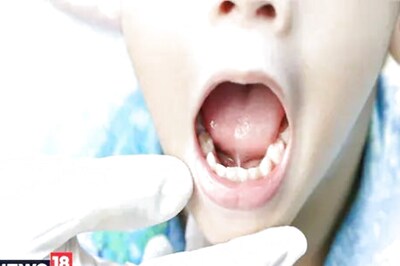
views
X
Trustworthy Source
Harvard Medical School
Harvard Medical School's Educational Site for the Public
Go to source
Luckily, we've compiled a complete guide on women's hair loss, including the steps you can take to prevent it, and the treatments that are available if you’ve already started to experience it. We’ll also go over the types and causes of women's hair loss, so keep reading!
Ways to Prevent Women’s Hair Loss
Reduce your stress levels. Severe stress can cause a type of hair loss called telogen effluvium. When this happens, fewer new strands of hair grow, and more strands than usual fall out (up to 300 strands on a daily basis, when the normal amount to lose per day is about 100 strands). Learning how to manage and decrease your stress levels may help prevent this type of hair loss. Here are some de-stressing tips: Try out relaxation techniques like deep breathing, yoga, or meditation Stay physically active and exercise on a regular basis Set aside time in your schedule to do things you enjoy Connect with loved ones and lean on them for emotional support Seek out treatment with a licensed therapist to address issues like anxiety or depression
Eat a healthy, balanced diet. Eating a diet that’s deficient in protein, vitamins, or minerals can lead to hair loss, and not eating enough food can have this effect as well. To prevent this type of hair loss, make it a priority to eat a balanced diet, filled with nutrients like protein, iron, zinc, and vitamins D and B. Here are some foods that are good sources of these nutrients: Iron: Red meat, poultry, eggs, green vegetables, fruits, fortified bread Zinc: Whole grains, legumes, meat, shellfish B vitamins: Meat, poultry, fish, dairy, eggs, fortified soymilk and cereals, asparagus, spinach, broccoli, legumes, whole grains, avocados, mushrooms Vitamin D: Fatty fish (salmon, trout, tuna), fortified milk and cereals Protein: Chicken, turkey, salmon, greek yogurt, eggs, tofu, tempeh, edamame, beans, lentils Try to eat between .8 g and 1 g of protein per each kg of your body weight on a daily basis. For example, if you weigh 170 lbs (77 kg), you should aim to eat 61.6 g of protein each day.
Take supplements to address any vitamin deficiencies. If you’re not getting enough of certain vitamins or nutrients in your diet, taking a supplement may help prevent hair loss associated with that deficiency. Your doctor can do a blood test to determine whether you have any deficiencies, and depending on your results, they may recommend vitamin D, biotin, zinc, collagen, or iron supplements. Be careful when purchasing supplements on your own. Supplements that are marketed for hair growth aren’t regulated for safety and effectiveness by the FDA, and products that contain too much of certain nutrients (like vitamin A or selenium) can actually make hair loss worse. Because of this, it’s best to ask your doctor’s advice about supplements for hair loss. They’ll be able to recommend the right supplements for you to take.
Avoid using harsh hair treatments and styling methods. Certain hair products like chemical relaxers and hair dyes can damage the hair shaft, leading to breakage and hair shedding.A lot of direct heat from styling tools like curling irons or straighteners can also cause these issues. Reducing your use of relaxers, dyes, and hot styling tools may help prevent this type of hair loss.
Avoid wearing tight hairstyles that pull on your scalp. Tight hairstyles that put a lot of tension on your hair follicles can lead to a type of hair loss called traction alopecia. It’s okay to wear these styles once in a while, but avoid wearing them all the time if you’re trying to prevent this type of hair loss. Hairstyles that cause pulling and tension include tight buns, ponytails, updos, braids, cornrows, locs, hair extensions, and weaves. If you’re getting a weave or braids, licensed cosmetologist and certified hair loss practitioner Courtney Foster recommends leaving out the portion of hair around the hairline, or making an effort to use “the least amount of tension” possible in this area. “Along the hairline, you want to make sure that portion of the hair is not tightly braided or tightly sewn, so that you reduce the potential of breakage and damage,” she explains.
Protect your hair from the sun. Excessive sun exposure can damage your hair’s cuticle (the outermost layer of each strand), which can make your hair drier, more brittle, and more prone to thinning and breakage. If you like to spend a lot of time out in the sun, protect your hair from UV rays with a hair sunscreen product. You can also wear a wide-brimmed hat, wrap your hair up in a scarf, or sit under an umbrella if you’re at the pool or beach.
Try out rosemary essential oil. Studies have shown that rosemary oil is very effective for combatting hair loss and encouraging hair regrowth. In fact, research suggests it may be as effective as minoxidil (also known as Rogaine), which is one of the most commonly prescribed medications for female pattern hair loss. If you want to try out rosemary essential oil, don’t put it on the hair itself, like you would for other hair oils or leave-in treatments. Instead, apply it directly to your scalp, and massage it in. Let the rosemary oil sit on your scalp for a few hours before washing it out to give it time to work its magic. You may want to try the oil on a small portion of your scalp first, to make sure it doesn’t cause any reaction on your skin.
Ask your doctor if any of your medicines can cause hair loss. Certain medications can potentially cause hair loss in women. These include retinoids, antibiotics, antidepressants, birth control pills, anti-clotting drugs, cholesterol-lowering drugs, high blood pressure medications, hormone replacement therapy, mood stabilizers, medications used during chemotherapy, and more. If you’re on any of these medications, your doctor can help you assess the risk of hair loss and recommend preventative measures or treatments.
Types of Hair Loss in Women
Androgenetic Alopecia (Female Pattern Hair Loss/Baldness) This is the most common type of hair loss that women and people assigned female at birth experience. The condition is hereditary, which means that it can run in your family. It causes the hair to thin all over your scalp, but it doesn’t typically cause a receding hairline or lead to complete baldness. For men and people assigned male at birth, on the other hand, receding hairlines and baldness are more common.
Anagen Effluvium This is a type of rapid hair loss that occurs after certain medical treatments, like chemotherapy. The medications used cause your hair follicles to halt production, leading to hair loss on your scalp and other areas of your body. Once the medical treatment ends, the hair usually grows back on its own, but your doctor can also prescribe medication to aid in this process.
Telogen Effluvium This type of hair loss occurs when a large number of follicles on your scalp enter the telogen phase of the hair growth cycle (the phase when hair sheds or falls out), but the next phase of the cycle doesn’t begin. This leads to a larger amount of hair loss without new hair growth. During telogen effluvium, you may lose 300-500 hairs per day, as opposed to 100 strands per day, which is the normal amount of daily hair loss.
What causes hair loss in women?
There are several possible causes of hair loss for women. These include lifestyle factors, medical conditions, and genetics. Here’s a list of several possible reasons for women's hair loss: Genetic predisposition (family history of male or female pattern baldness) Chemotherapy or radiation Prescribed medications (retinoids, birth control, antidepressants, etc) Iron deficiency/anemia Vitamin deficiency Thyroid disease Hormonal changes (pregnancy, menopause) Polycystic ovary syndrome (PCOS) Extreme physical stress (childbirth, severe infection, major surgery) Psychological stress, depression, or anxiety Insufficient nutrients in your diet Harsh hair styling products or tools Tight hairstyles that put too much tension on hair follicles
Treatments for Women’s Hair Loss
Topical minoxidil (Rogaine) If you’re experiencing hair loss, your doctor may recommend minoxidil, which is available over-the-counter in 2% and 5% strengths. Minoxidil can help slow or stop hair loss while also encouraging hair regrowth. If you decide to try out minoxidil, follow the application instructions listed on the specific product you have. Most will need to be applied directly to your dry scalp once or twice daily. You may notice an increase in hair loss at first. This is normal and will stop when your hair starts to regrow. Since hair takes time to grow, you’ll need to use minoxidil consistently for about 6-12 months before assessing whether or not it works for you. Minoxidil can cause hair to grow in places other than your scalp. To prevent this, avoid getting the minoxidil on other areas of your body, and wash your face and hands after applying minoxidil to your scalp. If you are pregnant, plan to become pregnant, or are breastfeeding, you should not use minoxidil.
Spironolactone, finasteride, and other anti-androgens Androgens (male sex hormones including testosterone) can accelerate hair loss in women. Because of this, drugs like spironolactone or finasteride (which have anti-androgen properties) are sometimes prescribed to treat female pattern baldness. These types of medications are especially effective for women who are experiencing hair loss as a result of PCOS, since this condition causes them to produce excess androgens.
Low-light laser treatments In some cases, low-level LED laser lights have been found to be helpful for regrowing hair. There are a few products on the market that utilize this technology, such as laser combs and laser caps, but only a few of them have earned FDA approval for the treatment of hair loss.
Platelet-rich plasma This treatment requires drawing your blood and taking platelet-rich plasma (PRP) from it, then injecting this substance back into your scalp. It has been found to be helpful for some people experiencing androgenetic alopecia, though research suggests that it works best when combined with other treatments like minoxidil or finasteride.
Microneedling Microneedling is a treatment that involves using very thin needles to make tiny holes in the scalp. Creating these tiny injuries jump starts your skin’s healing process, which leads to increased blood flow to the scalp. Microneedling before applying minoxidil can also make the minoxidil more effective, so the two treatments are often used in conjunction.
Hair transplants If you don’t respond well to other treatments, your doctor may recommend a hair transplant. This treatment involves removing tiny plugs of hair from other areas where your hair is thicker, then transplanting them to the areas that are thinning.
Styles for Thinning Hair
There are several ways to disguise thinning hair. You can style your hair differently, wear certain hair accessories, or even use products that fill in your hair line. Here are some suggestions to try out: Bobs or shorter hair cuts. A shorter, blunter hair cut can help your hair appear thicker and fuller. Side-swept bangs. Brushing bangs to one side can help disguise any thinning you may be experiencing around your hairline. Top knots. If you’re experiencing hair loss around the crown of your head, pulling your hair up into a topknot is a great way to hide it. Hairline powder. Hairline powder in your hair color can help disguise thinning around your hairline or the area where you’ve parted your hair. Hats or headbands. Headbands are perfect for hiding hair loss around your hairline, and hats can cover up hair loss in other areas of your scalp. Wigs or clip-in hair pieces. If you’re experiencing thinning around your hairline or crown of your head, clip on bangs and other hair pieces can be helpful. Or, if you’re experiencing severe hair loss all over, you can also opt for a full wig.


















Comments
0 comment